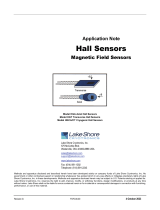
Demonstrations
Deflect the beam using an electric field
With no current in the Helmholtz coils, deflect the beam using
the deflection plates:
•Connect a wire between the Accelerating Voltage positive
terminal and the Deflection Plates Upper terminal to make
the electron beam deflect upwards.
•Switch the wire to the Deflection Plates Lower terminal to
make the electron beam deflect downwards.
Deflect the beam with a permanent magnet
Hold a permanent bar magnet near the tube to show the effect
of a magnetic field on the electron beam. Switch between
holding the north and south ends of the magnet near the beam.
Rotate the tube
Rotate the tube so that it is oriented at an angle with respect to
the magnetic field from the Helmholtz coils. As you rotate the
tube, observe how the beam deflection is affected.
Deflect the beam using Earth’s magnetic field
With no magnet and no current in the Helmholtz coils, rotate the
tube or the entire apparatus to see the deflection of the beam
due to the Earth’s magnetic field. Is the direction of the
deflection of the beam as you expect?
Sample data
Table 2. Sample Data
Trial U (V) IH (A) R (mm) e/m (C/kg) % error
1 100 1.0 45.0 1.80×1011 2.5
2 105 1.1 42.5 1.76×1011 -0.3
3 110 1.2 40.0 1.74×1011 -0.9
4 115 1.3 38.0 1.72×1011 -2.2
5 120 1.4 35.5 1.78×1011 0.9
Fuse replacement
WARNING: To reduce the risk of electric shock
or damage to the instrument, turn the power
switch OFF and disconnect the power cord
before replacing a fuse.
1. Disconnect the power cord from the instrument.
2. Open the fuse cover and remove the fuse. The fuse is
inside a tray above the AC power cord socket. Use a small
screwdriver or other tool to pry the tray open.
3. Replace the fuse with another fuse of the same type
(250 V T2A). One spare fuse is included inside the tray.
4. Reconnect the power cord and turn on the instrument.
Specifications and accessories
Visit the product page at pasco.com/product/SE-9629 to view
the specifications and explore accessories. You can also
download support documents from the product page.
Technical support
Need more help? Our knowledgeable and friendly Technical
Support staff is ready to answer your questions or walk you
through any issues.
Chat pasco.com
Phone 1-800-772-8700 x1004 (USA)
+1 916 462 8384 (outside USA)
Email support@pasco.com
Regulatory information
Limited warranty and limitation of liability
This Brolight product is free from defects in material and workmanship for one year
from the date of purchase. This warranty does not cover fuses, or damage from
accident, neglect, misuse, alteration, contamination, or abnormal conditions of
operation or handling. Resellers are not authorized to extend any other warranty on
Brolight’s behalf. To obtain service during the warranty period, return the unit to
point of purchase with a description of the problem. THIS WARRANTY IS YOUR
ONLY REMEDY. NO OTHER WARRANTIES, SUCH AS FITNESS FOR A
PARTICULAR PURPOSE, ARE EXPRESSED OR IMPLIED.BROLIGHT IS NOT
LIABLE FOR ANY SPECIAL, INDIRECT, INCIDENTAL OR CONSEQUENTIAL
DAMAGES OR LOSSES, ARISING FROM ANY CAUSE OR THEORY. Since some
states or countries do not allow the exclusion or limitation of an implied warranty or
of incidental or consequential damages, this limitation of liability may not apply to
you.
Product end-of-life disposal
This electronic product is subject to disposal and recycling regulations
that vary by country and region. It is your responsibility to recycle your
electronic equipment per your local environmental laws and regulations
to ensure that it will be recycled in a manner that protects human health
and the environment. To find out where you can drop off your waste
equipment for recycling, please contact your local waste recycle or disposal
service, or the place where you purchased the product. The European Union
WEEE (Waste Electronic and Electrical Equipment) symbol on the product or its
packaging indicates that this product must not be disposed of in a standard waste
container.
Product Guide | 012-14265F
5












